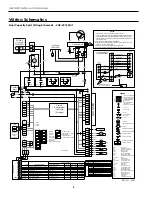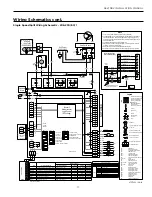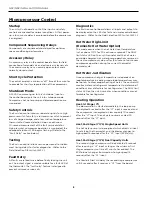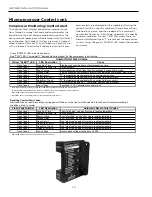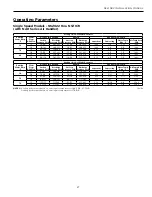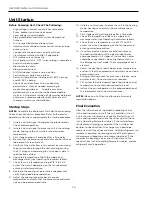
30
NSZ/NDZ INSTALLATION MANUAL
High voltage is correct and matches nameplate.
•
Fuses, breakers and wire size correct.
•
Low voltage wiring complete.
•
Piping completed and water system cleaned and
•
flushed.
Air is purged from closed loop system.
•
Isolation valves are open, water control valves or loop
•
pumps wired.
Condensate line open and correctly pitched.
•
Transformer switched to 208V if applicable.
•
DIP switches are set correctly.
•
DHW pump switch is “OFF” unless piping is completed
•
and air has been purged.
Blower rotates freely.
•
Blower speed correct.
•
Air filter/cleaner is clean and in position.
•
Service/access panels are in place.
•
Return air temperature is between 50-80°F heating
•
and 60-95°F cooling.
Check air coil cleanliness to insure optimum
•
performance. Clean as needed according to
maintenance guidelines. To obtain maximum
performance the air coil should be cleaned before
startup. A 10-percent solution of dishwasher detergent
and water is recommended for both sides of coil, a
thorough water rinse should follow.
Startup Steps
NOTES:
Complete the Equipment Start-Up/Commissioning
Check Sheet during this procedure. Refer to thermostat
operating instructions and complete the startup procedure.
Initiate a control signal to energize the blower motor.
1.
Check blower operation.
Initiate a control signal to place the unit in the cooling
2.
mode. Cooling setpoint must be set below room
temperature.
First stage cooling will energize after a time delay.
3.
Be sure that the compressor and water control valve or
4.
loop pump(s) are activated.
Verify that the water flow rate is correct by measuring
5.
the pressure drop through the heat exchanger using
the P/T plugs and comparing to unit capacity data in
specification catalog.
Check the temperature of both the supply and
6.
discharge water (see Operating Parameters tables).
Check for an air temperature drop of 15°F to 25°F
7.
across the air coil, depending on the fan speed and
entering water temperature.
Decrease the cooling set point several degrees and
8.
verify high-speed blower operation.
Adjust the cooling setpoint above the room
9.
temperature and verify that the compressor and water
valve or loop pumps deactivate.
Unit Startup
Before Powering Unit, Check The Following:
Initiate a control signal to place the unit in the heating
10.
mode. Heating set point must be set above room
temperature.
First stage heating will energize after a time delay.
11.
Check the temperature of both the supply and
12.
discharge water (see Operating Parameters tables).
Check for an air temperature rise of 20°F to 35°F
13.
across the air coil, depending on the fan speed and
entering water temperature.
If auxiliary electric heaters are installed, increase
14.
the heating setpoint until the electric heat banks
are sequenced on. All stages of the auxiliary heater
should be sequenced on when the thermostat is in
the Emergency Heat mode. Check amperage of each
element.
Adjust the heating setpoint below room temperature
15.
and verify that the compressor and water valve or loop
pumps deactivate.
During all testing, check for excessive vibration, noise
16.
or water leaks. Correct or repair as required.
Set system to desired normal operating mode and set
17.
temperature to maintain desired comfort level.
Instruct the owner/operator in the proper operation of
18.
the thermostat and system maintenance.
NOTES:
Be certain to fill out and forward all warranty
registration papers.
Final Evaluation
After the initial check of superheat/subcooling values
in the heating mode, shut off the unit and allow it to sit
3 to 5 minutes until pressures equalize. Restart the unit
in the cooling mode and check the values against those
in the Operating Parameters tables. If the unit performs
satisfactorily, charging is complete. If the unit does not
perform to specifications, the charge may need to be
readjusted until the values are close. Adding refrigerant will
increase subcooling. Recovering some of the refrigerant
will decrease subcooling and increase superheat. If the
superheat/subcooling values are still not close to the
specifications in the Operating Parameters tables, analyze
refrigerant circuit operation.

